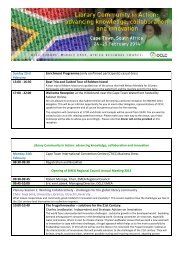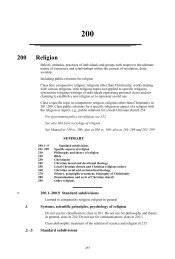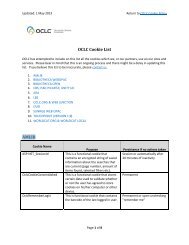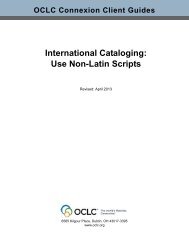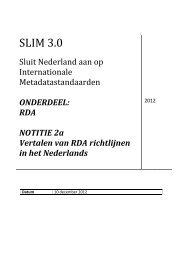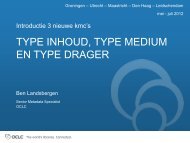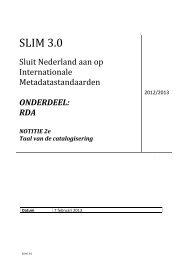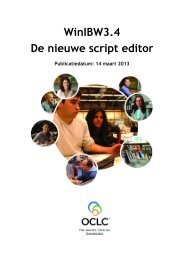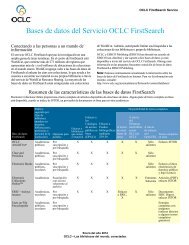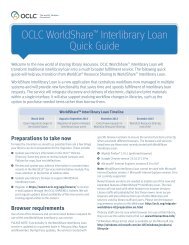4. Character Sets - OCLC
4. Character Sets - OCLC
4. Character Sets - OCLC
Create successful ePaper yourself
Turn your PDF publications into a flip-book with our unique Google optimized e-Paper software.
<strong>4.</strong>2 Non-Latin Script <strong>Character</strong> Set (continued)<br />
Subfield ‡6<br />
(continued)<br />
When there is no associated field to which a field 880 is linked, the occurrence<br />
number in subfield‡6 is 00. It is used if an agency wants to separate scripts in a<br />
record (see Multiscript Records). The linking tag part of subfield ‡6 will contain the<br />
tag that the associated regular field would have had if it had existed in the record.<br />
880 ##‡6530-00/(2/r‡a[Additional physical form available information in Hebrew<br />
script]<br />
[Field 880 is not linked to an associated field. The occurrence number is 00.]<br />
The occurrence number is followed immediately by a slash (/) and the script<br />
identification code. This code identifies the alternate script found in the field. The<br />
following codes are used:<br />
Code -- Script<br />
(3 Arabic<br />
(B Latin<br />
($1 Chinese, Japanese, Korean<br />
(N Cyrillic<br />
(S Greek<br />
(2 Hebrew<br />
880 1#‡6100-01/(N‡a[Heading in Cyrillic script]<br />
The entire field need not be in the script identified in subfield ‡6. If more than one<br />
script is present in the field, subfield ‡6 will contain the identification of the first<br />
alternate script encountered in a left-to-right scan of the field.<br />
Note also that the script identification code is used in field 880, subfield ‡6, but this<br />
data element is not generally used for subfield ‡6 of the associated regular field. In<br />
the associated field, the data is assumed to be the primary script(s) for the record.<br />
In a MARC record, the contents of field 880 are always recorded in their logical<br />
order, from the first character to the last, regardless of field orientation. For a display<br />
of the field, the default field orientation is left-to-right. When the field contains text<br />
that has a right-to-left orientation, the script identification code is followed by a slash<br />
(/) and the field orientation code. The MARC field orientation code for right-to-left<br />
scripts is the letter r. The orientation code is only included in fields with right-to-left<br />
orientation, since left-to-right orientation is the default<br />
orientation in 880 fields. (See MARC 21 Specifications for Record Structure,<br />
<strong>Character</strong> <strong>Sets</strong>, and Exchange Media for a detailed description of field orientation.)<br />
110 2#‡6880-01‡a[Heading in Latin script]<br />
880 2#‡6110-01/(2/r‡a[Heading in Hebrew script linked to associated field]<br />
Note that the orientation code is used in field 880, subfield ‡6, but this data element<br />
is not generally used for subfield ‡6 of the associated regular field. In the associated<br />
field, the data is assumed to be the usual orientation of the primary script(s) for the<br />
record.<br />
<strong>4.</strong> <strong>Character</strong> <strong>Sets</strong> 4:13



